
TODAY’S LESSON: The warm spring days and cool, foggy nights are the perfect weather to bring the artichoke crop to its harvest. What better way to celebrate the arrival of spring than with an easy but elegant Fried Crispy Artichokes.
WHAT EXACTLY IS AN ARTICHOKE? The artichoke is an immature bud of a flower belonging to the thistle family. The proverbial cliche, “nipped in the bud,” applies directly to the artichoke as it is harvested prior to its blossom into a purplish-violet bloom or thistle. There are prickly leaves surrounding the fibrous fuzzy choke which sits atop the treasured edible fleshy base or “heart”.
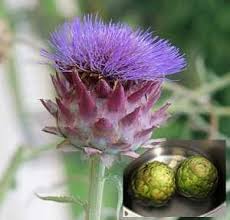
The size of the artichoke can vary from small to softball sized all of which can be found growing on the same plant. The large artichokes are the primary buds of the plant while the medium and smaller ones grow on side lateral branches. They are harvested by hand.
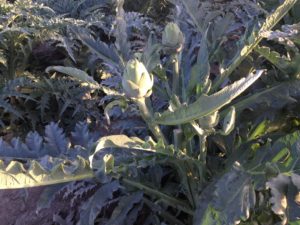
WHERE DOES THE ARTICHOKE COME FROM? The origin is somewhat foggy, perhaps Carthage, as the ancient name for artichokes could also have meant a close cousin the cardoon which was popular in those days. We do know that it is a native of the Mediterranean region with Sicily its’ first clearly identified area of cultivation. The artichoke was first introduced into Europe in the fifteenth century through Naples, on into Florence and finally into Tuscany about fifty years prior to Catherine de’Medici’s birth in 1519. Catherine de’Medici was believed to have introduced the artichoke to France. Catherine had an uncanny fondness for the artichoke much to the distress of her society who disdained a young woman (Catherine was fourteen when she married Henry II) eating a vegetable known to be an aphrodisiac. As you can imagine, such behavior only helped it gain in popularity.
The Spanish originally introduced the artichoke into America but apparently took it with them when they left. In 1900, it was re-introduced into the United States, by Italian immigrants to Half Moon Bay, California. The artichoke prospered in the cool climate having its first commercial crop in 1906. The center of production is now Castroville, which produces virtually all the artichokes for the United States market.
ADVANTAGES: Artichokes are rich in potassium, iron, vitamins A, B and C. They are low in sodium with only .2 percent fat. Artichokes are relatively low in calories…only about 63 calories in a 3-1/2 ounce serving.
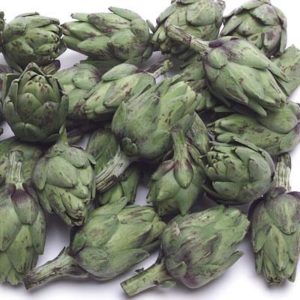 SELECTING YOUR ARTICHOKE: For our Crispy Artichokes select baby or very small artichokes that are firm and heavy. Lower temperatures during the final growing days may bronze the leaf tips but produce the best vegetable flavor. Avoid artichokes with spreading leaves or those that show signs of blackening or spoilage. Check the stem end, it should be freshly cut and stiff not soft and shriveled.
SELECTING YOUR ARTICHOKE: For our Crispy Artichokes select baby or very small artichokes that are firm and heavy. Lower temperatures during the final growing days may bronze the leaf tips but produce the best vegetable flavor. Avoid artichokes with spreading leaves or those that show signs of blackening or spoilage. Check the stem end, it should be freshly cut and stiff not soft and shriveled.
PREPARING YOUR ARTICHOKE: Bring a large pot of water to a boil. Season the water with salt. Add the artichokes and cook until tender, as checked by inserting a skewer without resistance into the heart through the base of the stem. Drain in a colander saving some of the cooking liquids. Take half of the artichokes and place in a blender in batches with enough of the cooking liquid to puree until smooth and the consistency of stock. Strain through a fine sieve and use as part of the risotto cooking liquids. Trim the coarse outer leaves, leave tips and stems from the remaining artichokes. Cut the baby artichokes into halves and reserve.
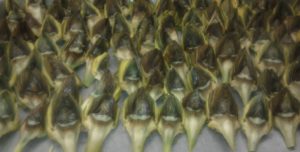
TRICKS OF THE TRADE: Thoroughly cook the artichoke to kill the natural enzymes that will cause the flesh to turn black even before cutting.
TRY YOUR TECHNIQUE: Golden Crispy Artichokes with Lemon and Garlic will get your flavor buds going
Golden Crispy Artichokes with Lemon & Garlic
Makes 4 servings of about 11 grams carbohydrates,
3 grams of protein and 3 grams of fiber each
Prep time 30 minutes Cook time about 15 minutes
24 baby or small artichoke hearts (C=24g)(P=8g)(F=12g)
2 tablespoons Extra Virgin Olive oil (C=0g)
4 cloves of fresh garlic, sliced paper thin (C=4g)
4 tablespoons lemon juice(C=5.2g)
1 tablespoon lemon rind, grated fine (C=1g)
1/4 cup chopped fresh basil (C=.4g)
Flake Sea salt (C=0g)
Freshly ground black pepper (C=1g)
1 cup miniature red, yellow and orange sweet peppers, cut into full circles (C=8g)
In a large pot of boiling salted water, cook the artichokes until tender as tested by inserting a skewer without resistance into the heart through the base of the stem. Drain in a colander and allow to cool.
Cut the artichokes into halves then trim of the coarse outer leaves and fibrous stems. Reserve.
In another large pot, heat the oil necessary for frying the artichokes to 360 degrees F. over medium to high heat. Carefully add the artichokes cooking until the fanned outer leaves are golden, about 34 minutes. Add the slivered garlic cooking for 30 seconds. Remove the artichokes and garlic from the oil and transfer to paper towel to absorb any excess oil. Transfer immediately to a large bowl. Add the lemon juice, lemon rind, and basil. Season well with salt, black pepper and if you choose red pepper flakes for more kick. Toss well to evenly mix the ingredients and coat the artichokes. Transfer to the warm serving bowls or plates. Serve
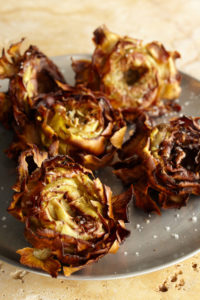 COOKING NOTE I: (C=0g)(P=0g)(F=0g)indicates the total carbohydrates, total protein & total fiber in grams for the ingredient listed.
COOKING NOTE I: (C=0g)(P=0g)(F=0g)indicates the total carbohydrates, total protein & total fiber in grams for the ingredient listed.
© Jimmy Schmidt
Jimmy this sounds wonderful. Love the history behind the food!
Comments are closed.